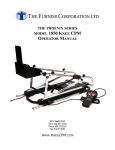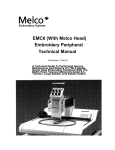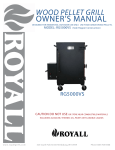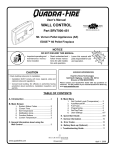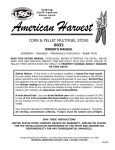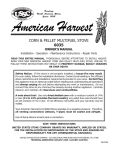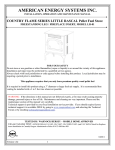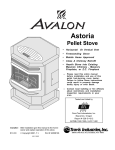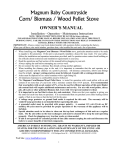Download American Energy Systems J3500 Owner`s manual
Transcript
Troubleshooting Quick Guide Information MagnuM Baby Countryside & MagnuM Winchester 1. Fire burns lazy and window builds up with soot. Venting plugged- Check/clean venting. Venting not installed correctly- Change venting configuration. Knock out plug(s) not installed properly- Install or replace plugs. Wet fuel- Change fuel, or bring up to room temp. before placing in stove. Dirty fuel- Run fuel through screener, or change fuel supplier. Lack of fresh air- Hook up to outside air source, or clean intake pipe. Firepot not seated properly in cradle- Make adjustments to make sure the firepot is seated firmly in cradle. If the firepot has warped, this will cause the air to flow around the firepot, rather then through it causing incomplete combustion. Also make sure the igniter, or plug is not stopping the firepot from sitting properly. Weak/bad draft blower- Check ohms/amps to make sure the motor is operating properly and replace if needed. Also check connections going to the draft blower confirming continuity in wiring harness. Door/ash pan door not sealing- Adjust door and/or replace gasket if needed. Voltage going to draft blower is low- Check continuity of wiring harness and replace ends, or wiring harness if needed. If there is no power coming from the control panel it needs to be replaced. The power going to the draft blower fluctuates depending on heat setting, so check all settings. Manual draft not opened up far enough- Open up draft damper. Firepot dirty- Remove clinker from firepot. Lack of maintenance and dirty/wet fuel are the leading cause of problems with any stove. Make sure you follow manufacturing directions by cleaning the stove on a regular basis. Also, get your fuel from a reliable source and make sure it is stored properly!!!! 2. Fire goes out, or stove shuts down automatically. The #2 heat level light is flashing- The stove’s vacuum switch tripped. Check venting, doors, tubes, and vacuum switch. Possible negative pressure in home, or venting configuration incorrect. Stove ran out of fuel- Load hopper. Auger jammed- Empty hopper and remove foreign object. The #3 heat level light is blinking- Proof of fire disk opened because the stove wasn’t hot or the disk needs to be replaced. High temperature snap disk tripped- Stove overheated and the snap disk has to be reset. Possible causes for overheating include: room fan not working/not getting enough power or plugged, stove is plugged, jumper for feed rate in the wrong position, negative pressure in the AES Technical Bulletin #T-0068 Date of Issue 06/22/2007 home, unacceptable fuel being burned in the stove, inadequate air flow around the stove, high limit switch was bumped causing it to trip, etc. Poor quality or wet fuel- screen or dry fuel. Incorrect draft/feed rate setting- Either the draft or the feed rate is off and should be adjusted. 3. Fuel will not feed. Hopper is empty- Add fuel to hopper. Auger is jammed- Remove obstruction. High limit is tripped- Reset snap disk. Vacuum switch is not engaging- check seals on doors and/or check connections. Fuel is dirty or wet- Remove fuel and re-load hopper with clean dry fuel. Auger tube is scored- Hone, or buff, out auger tube. Set screw for the auger is loose- Tighten set screw on the flat part of the auger motor shaft. Circuit board not sending power to auger motor- Replace circuit board. MagnuM Winchester units only- Hopper lid safety switch is not engaging. The MagnuM Winchester heating appliances are equipped with a hopper lid switch, which will cause the auger to stop turning when the hopper lid is lifted. The switch is wired in line with the auger motor. 4. Stove runs for 10 to 15 minutes then shuts down. The stove didn’t get up to temperature- Restart stove. Air damper not adjusted appropriately- Adjust damper accordingly. Inappropriate starter or fuel being used- Use wood pellets are other approved materials to start the stove. The proof of fire snap disk not engaging- replace snap disk, or test wires leading to the snap disk. 5. Blower will not shut off after the stove has been turned off and cooled off. The proof of fire snap disk is stuck in the closed position- Replace. Stove has not cooled off completely- The stoves can take up to two hours before the fans shut off. 6. Blower will not operate. Check power going to the stove- Plug the stove in. Proof of fire snap disk hasn’t engaged- check leads and snap disk. The blower is getting power, but not turning- Replace blower. The blower is not getting power- Check continuity of wires going to blower and if they check out replace control panel. Blower is overheating and shutting off- take blower out, clean, and lubricate. It is very important to clean and lubricate the blower at least once a season. If the homeowner has pets the cleaning should be done more often. 7. Soot or fly ash in the house. Maintenance on the stove- Follow the manufactures guidelines for cleaning the stove on a consistent basis. Shop Vac or regular household vacuum being used- The filters in these vacuums aren’t designed to filter out the fine ash generated by the stove. It is strongly recommended that an Ash Vac be used for cleaning the stove. AES Technical Bulletin #T-0068 Date of Issue 06/22/2007 Cleaning the glass when the stove is running- Make sure to use a damp rag, or towel, this will collect the ash rather then push it into the air. It is also a good idea to wait until the stove is shut down to clean the glass. Negative air pressure in the home- This will cause the ash and soot to be drawn into the home, rather then out the exhaust. Venting not sealed- The stove is a negative air flow system. If there is a leak in the air shell, or heat exchange tubes the fire will die out. Make sure all joints are sealed along with the wall thimble. Also make sure the hopper is sealed properly. If there are any leaks along the hopper fines will fall into the cabinet and be blown out by the room fan. Emptying the ash pan- When removing the ashes from the ash pan make sure to cover the ash pan and dump outside. When dumping the ashes in the house, or walking through the house with the ash pan uncovered, it will allow the ashes to be blown through out the home. Dirty fuel used when filling the hopper- When dumping fuel into the hopper it can cause a “cloud” of fines or dust to form. This cloud then can be sucked into the cabinet and blown through the heat exchange tubes. The tubes will usually cause the dust to become singed and therefore look like soot. Make sure to screen the fuel outside before bringing into the home. It is also a good idea to fill the hopper slowly in order not to kick up dust. Gasket on draft blower not sealing properly- Replace gasket on draft blower. It is good idea to replace this gasket every time the draft blower is taken off to make sure it has a good seal. Leaving the door open too long when removing the clinker- If there is a lot of activity, when removing the clinker, this will allow ash to get blown into the house. When removing the clinker make sure to drop it into the ash pan, or approved containment device, quickly and close the door. Exhaust was terminated next to a window, or other air inlet- Move exhaust termination. There is an existing fireplace in the home- Have a certified chimney sweep clean the flue and make sure it is sealed properly. It is possible for a chimney to reverse its draft and pull soot into the home. 8. Build up of soot on glass, venting, and heat exchangers. Fuel too wet/dirty- Use clean and dry fuel. If storing fuel outside make sure to bring it up to room temperature before dumping it into the hopper. Fresh air not hooked up/plugged- It is a requirement to have the fresh air hooked up to all of our products. Check air intake for any obstructions, or unusual runs. Make sure to ask the customer if they plugged the intake themselves in the spring after shutting down the stove. Air wash plugged, or out of adjustment- The air wash is located along the bottom of the door opening. There is a small gap, equal in width to the cradle, which allows air to flow over the glass. Part of this combination is a piece of steel that is welded in at an angle to direct the air. If the gap is plugged, or if the steel bracket is bent it will not allow air to flow over the glass keeping it clean. Trying to adjust the bracket should be a last resort and only be done be a factory trained technician. Clinker not being removed on a timely basis- This will cause the stove to burn dirty and start plugging up. It is important to keep in mind heat setting and fuel quality when deciding to remove the clinker. If the clinker is not removed the stove will fill up and shut off. 9. Fuel burns off too quickly; have difficulty keeping a pilot fire. Air damper is wide open- Adjust air damper to the proper position for the fuel being burned. Outside air is not hooked up- Hook up outside air. Not having adequate make up air will cause the stove to burn dirty and put itself out, or lead to other problems. AES Technical Bulletin #T-0068 Date of Issue 06/22/2007 Over drafting on a vertical install- If the install is using an existing chimney it is important to run the appropriate liner for the stove. The auger trim may have to be adjusted in order to maintain the pilot fire. Positive or negative pressure of the home- Pressure in the home will cause inconsistent drafting of the stove. This can cause the fuel to burn up too quickly, or not fast enough causing the stove to shut down. Dirty fuel- Pieces of cob, stalk, or leaves will cause the corn to get hung up and not drop into the firepot consistently causing the fire to burn itself out. 10. Foreign object caught in the auger and will not turn. An object has gotten into the hopper and caused the auger to stop turning- Remove object by relaxing tension on the auger. DO NOT try to remove the object by hitting, or prying on it! To release tension on the motor, loosen set screw and remove the auger motor. The other option is to remove the auger motor stop bolt. On DC models it is possible to switch the wires leading to the motor, this will cause the motor to turn in the opposite direction. Depending on the damage done to the auger it might be necessary to lightly buff down any burrs or rough areas. 11. The stove is generating too much ash. Ash is directly related to quality of fuel, stove efficiency, operation, and install. All solid burning appliances generate ash to a certain degree depending on the factors listed earlier. The following are areas that should be looked at in order to help reduce the amount of ash generated by the stoves. Dirty fuel- Run the fuel through a screener to remove fines and other debris. Because of the air flow going through the firepot most of the fines don’t even get burned, they end up as ash on the inside of the stove and have no heat value whatsoever. Wet fuel- Only burn fuel that is at the appropriate moisture levels mentioned in the owner’s manuals. Store fuels in proper containers and bring the fuel up to room temperature before dumping into the stove. Burning wet fuel causes incomplete combustion and may cause the stove to create a “creosote” like coating inside the burn chamber and exhaust system. Lack of clean combustion air- Be sure to check the surrounding area where the fresh air intake terminates. Stay away from clothes dryers, water heater terminations, or any other item that may cause the fumes to get sucked back into the stove. Dirty or plugged stove/venting- Make sure to perform the suggested maintenance instructions on the schedule listed in the owner’s manual. Combustion blower going out- Check amp draw, voltage, continuity, and ohms for the draft blower. Use combustion enhancement system- The CES is designed to re-direct some of the ash back to fire pot when it would otherwise be blown out of the fire pot. The CES also increases the overall efficiency of the stove. The one drawback is that it blocks part of the view of the flame, which most homeowners enjoy. Air intake is too close to the exhaust- Make sure to observe proper clearances when installing the venting. Drawing in exhaust fumes will cause the stove to lose clean combustion air and burn dirty. 12. The heat output is not as high as when the unit was installed. AES Technical Bulletin #T-0068 Date of Issue 06/22/2007 Wet/dirty fuel- Make sure to use up all of the fuel at the end of the season- do not try to carry fuel over to the next season. All types of fuels can take on moisture over the summer unless it is properly stored, so it is a good idea to start with fresh fuel at the beginning of a heating season. Inadequate cleaning- Make sure to follow the end of the season cleaning procedures in the owner’s manual. A stove that is full of ash won’t be as efficient and heat output will be considerably lower. Different type of fuel- Different types of fuel will have different heat outputs. Corn will vary in heat output depending on the breed, size, shape, and chemical makeup. Wood pellets will be different depending size, manufacturer, and makeup. Negative/improper pressure inside the home- Check the installation configuration for any changes. Find out if there have been any “improvements” to the home since the unit was installed. A lot of times people will update windows, siding, or put on additions to the home. This can have an affect on the entire house and how the appliances operate. The following are the motors located in the stove with symptoms and solutions when they start to go out: Draft blower- Also known as the exhaust blower, or the combustion blower. The draft blower is located on the right side of the stove when looking at it from the front. The draft blower is responsible for creating a negative draft inside the stove. This will cause fresh air to be drawn in the intake, pass through the exhaust system, and out into the venting. The venting would then have a positive pressure. The draft blower will receive different amounts of voltage depending on the heat setting. During start-up the draft blower will receive full voltage for the first 8 to 10 minutes. After the stove is in the normal run mode the voltage to the motor will change when the heat setting changes. There are a couple different things that can be checked to make sure the draft blower is operating properly. During operation check the amp draw of the motor. The amp rating is located on the label of the motor. If the amp draw is exceeding the number given- replace the draft motor. Check the ohms of the motor. If there is no resistance, or high resistancereplace the motor. Check the voltage going to the motor to make sure it is getting the correct voltage. Also check the continuity of the wires- make sure to move them around to check for any variations. On the exhaust manifold there is also an inspection plug, which should be removed once a month for maintenance. If there is a build up on the fan blades the above checks should be done. A draft blower that is allowed to be plugged up will not be a warranty item. If the draft blower is still in working order, but has a layer of “creosote” on the fan blades it can be cleaned. Take off the draft motor and spray on an oven cleaning solvent to the fan blades. Follow the directions listed on the can. Remount the draft blower to the stove and make sure the gasket is sealing properly. Get a hold of some clean dry fuel (a 75%corn 25%wood pellet combination works great). Start the stove and get a nice fire going. Turn the stove up to the highest heat setting. Burn the stove on high for several hours to make sure the unit gets nice and hot. This will help clean the unit by burning off any signs of incomplete combustion. AES Technical Bulletin #T-0068 Date of Issue 06/22/2007 Room fan- Also known as the convection blower or the fan that blows the air into the room. The room fan is located on the left side of the stove when looking at it from the front. The room fan is responsible for blowing air through the air shell and heat exchange tubes. The room fan will receive full voltage on heat setting #2 and above. The voltage to the room fan will be lower on the #1 heat setting. The voltage to room fan can be changed to full voltage by pressing the fan button located on the control panel. The room fan should be taken out and cleaned at least once a year. If the homeowner has pets, the blower should be taken out more often to clean out any hair that may have built up in the squirrel cage. There are also a couple of lubrication points that can be oiled. The blower’s label displays the different electrical requirements of the blower. If the blower starts slowing down, or stopping, check the amp draw. If the amps are high- replace the motor. An ohms check can also be done to check the circuit. It is also a good idea to check the wiring harness and the voltage going to the motor to see if it is appropriate. Auger Motor- The auger motor is located at the base of the auger. The motor is held on be one set screw to the auger. There are two bushings on the auger system- one is a bronze bushing located at the top and a delron bushing at the base. The long bolt next to the auger motor is meant to act as a stop for the motor. In case of an auger jam the bolt can be removed to release tension on the motor/auger. The auger motor does not receive varying voltage- it is either on or off. The on/off time will vary depending on heat setting. The auger motor for the MagnuM Baby Countryside and MagnuM Winchester is the same as the fuel stirrer motor on the MagnuM Countryside. If the auger motor isn’t running check the high limit snap disk, voltage going to the motor, obstructions in the auger, the vacuum/pressure switch, and continuity of the wiring harness. If the auger motor is run on a high heat setting and if there isn’t proper air circulation the motor will overheat and shut off. It is important to have adequate air flow in the room that the stove is operating in, if not the heat will not transfer to other areas of the home. Sensors- There is 3 sensors located in various areas on the stove. The proof of fire snap disk is located in the draft fan housing. The snap disk will have 2 brown wires connected to it. The snap disk is a 110 degree N/O snap disk. The proof of fire snap disk also turns the room fan on when the switch closes. The high limit snap disk is located on the underside of the auger tube with 2 orange wires connected to it. The snap disk is a 225 degree, N/C, manual reset disk. The vacuum switch is located in the bottom of the stove underneath the exhaust manifold. The vacuum switch will have a tube and 2 grey wires running to it. The switch can be hooked up either in the N/C or N/O position. The vacuum tube is connected to a metal tube, which leads to the area behind the ash pan in the upper right corner. It is possible for the metal tube to corrode shut, which will affect the vacuum sensor. AES Technical Bulletin #T-0068 Date of Issue 06/22/2007






